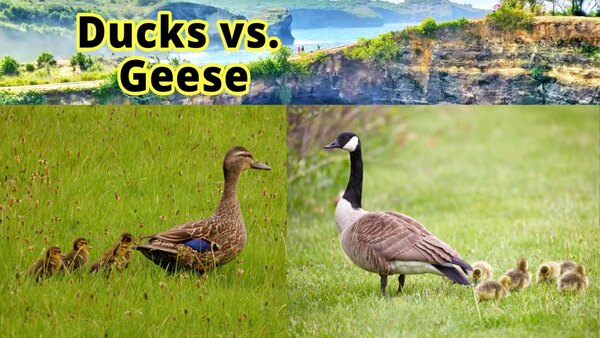When you think about waterfowl, ducks and geese are two birds that might come to mind. While both belong to the same family—Anatidae—they have key differences that set them apart in terms of behavior, physical traits, and even culinary use. In this article, we'll dive into these differences, including how they are raised, their popularity around the world, and how many are harvested each year for various purposes.

Ducks and geese share many similarities, such as living in similar habitats, having webbed feet for swimming, and often migrating long distances. However, when you look closely, there are several notable differences that make them unique. Here's a detailed comparison of ducks and geese:
| Characteristic | Ducks | Geese |
|---|---|---|
| Size | Smaller, typically 12–30 inches in length | Larger, usually 24–45 inches in length |
| Weight | Typically 1–4 lbs | Heavier, usually 5–14 lbs |
| Neck Length | Shorter necks, often compact | Long necks, especially in species like the Canada Goose |
| Head Shape | Round or slightly pointed heads | Larger, more pronounced heads |
| Habitat | Prefer freshwater lakes, ponds, and rivers | Prefer larger bodies of water, including lakes and wetlands |
| Diet | Omnivorous, often eat plants and small animals | Mostly herbivores, consuming grasses and other vegetation |
| Behavior | Often solitary or in small groups | Tends to live in larger flocks, especially during migration |
| Migration | Migrates short to medium distances | Long-distance migrators, often traveling thousands of miles |
| Vocalization | Quacking sounds | Honking sounds, louder and more resonant |
| Eggs | Typically smaller, softer shells | Larger, harder shells |
| Lifespan | 5–10 years in the wild | 10–25 years in the wild |
Ducks: Ducks come in a wide range of colors, with species such as mallards having a distinctive green head (for males). They generally have short necks and compact bodies, making them appear smaller and lighter.
Geese: Geese, on the other hand, are larger birds, with long, graceful necks and more pronounced bodies. Their feathers are often darker, with many species having white markings on the head or neck, such as the Canada Goose.
Both ducks and geese are heavily hunted for food, sport, and other uses, such as feathers and down. Hunting numbers can vary year to year based on regulations, migration patterns, and other factors. Here's an overview of global numbers related to the hunting of ducks and geese:
| Species | Estimated Global Harvest (Annually) | Top Producing Countries | Common Uses |
|---|---|---|---|
| Ducks | Over 100 million ducks are harvested annually globally | United States, China, France, Argentina | Meat (popular in gourmet dishes like Peking duck), feathers, down |
| Geese | Around 30–40 million geese are harvested annually worldwide | Canada, United States, Russia, and parts of Europe | Meat (often used in pâté and foie gras), feathers, down |
Both ducks and geese are popular in various cultures, with each bird having a unique place in global cuisine, folklore, and even symbolism.
Ducks: Ducks are more commonly consumed globally, especially in China, where Peking Duck is a well-known dish. Ducks are also farmed for their eggs and feathers. In the United States, duck hunting is a popular recreational activity, particularly in the southern states.
Geese: While not as commonly consumed as ducks, geese are considered a delicacy in many countries. In particular, foie gras (a dish made from fattened goose liver) is a famous French delicacy. Geese are also symbolically important, often representing traits like loyalty and endurance in various cultures.
Hunting laws for both ducks and geese are strictly regulated in many parts of the world to ensure that these species do not face over-exploitation. In the United States, for example, the Migratory Bird Treaty Act regulates the hunting of migratory birds, including ducks and geese, ensuring that hunters follow seasons and bag limits. However, there is an ongoing debate about the ethics of hunting, particularly with regards to practices like foie gras production, which has sparked controversy over animal welfare.
Conservation groups have been actively working to protect waterfowl populations. Many species of ducks and geese are now under protection, especially those that are endangered or face habitat destruction due to human activities.
Ducks: Some species of ducks, like the Northern Pintail, have seen a decline in numbers due to habitat loss and climate change. Organizations like Ducks Unlimited have been working to protect wetlands and restore habitats to ensure that duck populations remain sustainable.
Geese: Similarly, geese populations like the Snow Goose have been impacted by habitat loss and overhunting in the past. However, some species, like the Canada Goose, have made a significant recovery due to conservation efforts and the establishment of hunting regulations.
Both ducks and geese have unique characteristics that make them fascinating creatures. While ducks are more popular globally in culinary dishes, geese are prized for their meat, feathers, and symbolic value. The key differences in their size, behavior, and migration patterns make them interesting to study, and each has its own role in ecosystems.
As for hunting and farming, both ducks and geese continue to be important to the global food industry, with millions being harvested annually. However, with growing conservation efforts and ethical debates about hunting practices, the future of waterfowl populations will largely depend on sustainable practices and responsible consumption.
Whether you're a birdwatcher, a foodie, or just someone curious about waterfowl, understanding the differences between ducks and geese enriches our appreciation of these remarkable creatures.
We created this article in conjunction with AI technology, then made sure it was fact-checked and edited by a Animals Top editor.